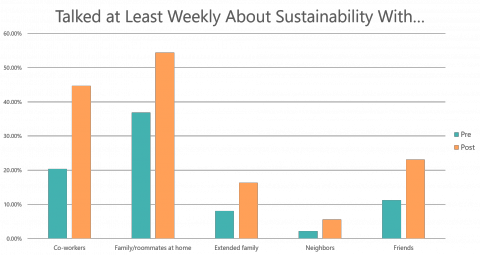Culture Change—You Need It So How Do You Know If You’ve Got It?
Achieving aggressive sustainability goals—whether within corporate operations or as part of a community’s quest for zero carbon emissions—is an enormous task.
In the early phases of any entity’s sustainability efforts a committed green team can do a lot. A small group of people can identify and address opportunities. As a company (or community) become more efficient, though, the projects get more complicated. And the projects involve more stakeholders. One of the ironies of sustainability efforts is that the more you succeed the more challenging it is to expand that success.
Sooner or later—especially if you’ve got aggressive goals—success requires all hands on deck. A company can’t achieve zero landfill unless everybody does their part in the lunch room. Similarly, a dramatic reduction in fleet emissions is possible only if every driver does their part.
Achieving aggressive sustainability goals requires culture change.
At Cool Choices we talk a lot about the need for culture change. We share stories from partners who’ve got “an entire employee population moving in the same direction.” We love that moment when our partners get it–when they see culture change happening in their organization.
How do you know, though, if you are achieving culture change?
Culture is what people say and do. The simplest way to assess the current culture is to monitor practices—what’s the recycling rate? Do employees volunteer new opportunities for saving resources or do all ideas come from the people tasked with these efforts?
Sustainability leads, then, need to transform this culture—to create a culture where people think about resource use and identify opportunities to reduce use. A culture where reducing waste is a shared value.
And as sustainability leads work on culture there’s a lot you can learn by just observing but for real proof we suggest you use surveys to measure culture change. Cool Choices does this in its own work and we focus on two metrics: how often employees talk to other people about sustainability and whether employees think other people value sustainability.
We ask about the frequency of conversations because people talk about what matters to them. If you want a culture of sustainability then you want people talking to each other about sustainability. You want them talking about sustainability at work, at home, and across the community. In our programs we’ve seen sustainability conversations increase dramatically. In a typical baseline about 20% of respondents say that they talk about sustainability at least weekly with their colleagues, compared to more than 50% at the end of a game. This is what you want—spontaneous conversations about sustainability because those conversations are evidence of shared values.
Then, to get even deeper, we ask folks if sustainability is important to their family, their colleagues, their friends, and even leadership at the company. What people think matters to other people is vitally important. We’ve seen numerous workplaces where three-quarters of employees reported that sustainability mattered to them personally while reporting that less than half of their colleagues cared about sustainability. This is a problem! If I think my peers aren’t interested in sustainability I’m not going to stick my neck out to make a difference.
Culture change starts when people realize that they have shared values and that there’s opportunity to express those values.
To learn more about how Cool Choices can help you assess and then accelerate culture change around sustainability, check out our webinar on this topic.
Comments are closed.





